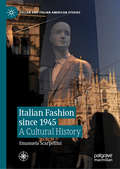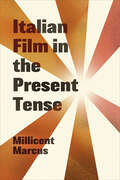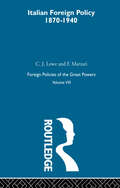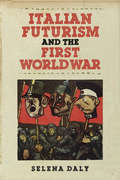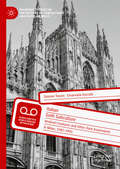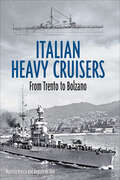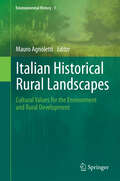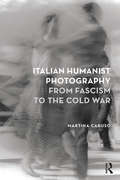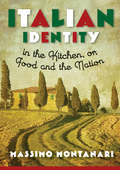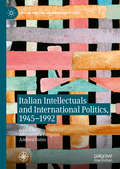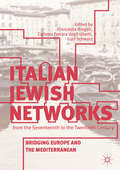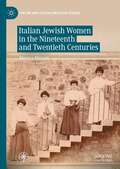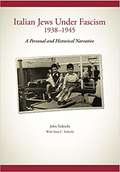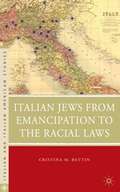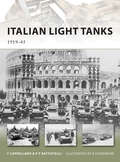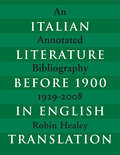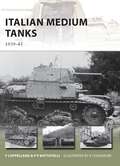- Table View
- List View
Italian Fashion since 1945: A Cultural History (Italian and Italian American Studies)
by Emanuela ScarpelliniIn the course of the twentieth century, Italy succeeded in establishing itself as one of the world's preeminent fashion capitals, despite the centuries-old predominance of Paris and London. This book traces the story of how this came to be, guiding readers through the major cultural and economic revolutions of twentieth-century Italy and how they shaped the consumption practices and material lives of everyday Italians. In order to understand the specific character of the “Italian model,” Emanuela Scarpellini considers not only aspects of craftsmanship, industrial production and the evolution of styles, but also the economic and cultural changes that have radically transformed Italy and the international scene within a few decades: the post-war economic miracle, the youth revolution, the consumerism of the 1980s, globalization, the environmentalism of the 2000s and the Italy of today. Written in a lively style, full of references to cinema, literature, art and the world of media, this work offers the first comprehensive overview of a phenomenon that has profoundly shaped recent Italian history.
Italian Film in the Light of Neorealism
by Millicent MarcusThe movement known as neorealism lasted seven years, generated only twenty-one films, failed at the box office, and fell short of its didactic and aesthetic aspirations. Yet it exerted such a profound influence on Italian cinema that all the best postwar directors had to come to terms with it, whether in seeming imitation (the early Olmi), in commercial exploitation (the middle Comencini) or in ostensible rejection (the recent Tavianis). Despite the reactionary pressures of the marketplace and the highly personalized visions of Fellini, Antonioni. And Visconti, Italian cinema has maintained its moral commitment to use the medium in socially responsible ways--if not to change the world, as the first neorealists hoped, then at least to move filmgoers to face the pressing economic, political, and human problems in their midst. From Rossellini's Open City (1945) to the Taviani brothers' Night of the Shooting Stars (1982). The author does close readings of seventeen films that tell the story of neorealism's evolving influence on Italian postwar cinematic expression.Other films discussed are De Sica's Bicycle Thief and Umberto D. De Santis's Bitter Rice, Comencini's Bread, Love, and Fantasy, Fellini's La strada, Visconti's Senso, Antonioni's Red Desert, Olmi's Il Posto, Germi's Seduced and Abandoned, Pasolini's Teorema, Petri's Investigation of a Citizen above Suspicion, Bertolucci's The Conformist, Rosi's Christ Stopped at Eboli, and Wertmuller's Love and Anarchy, Scola's We All Loved Each Other So Much provides the occasion for the author's own retrospective consideration of how Italian cinema has fulfilled, or disappointed, the promise of neorealism.
Italian Film in the Present Tense (Toronto Italian Studies)
by Millicent MarcusFor observers of the European film scene, Federico Fellini’s death in 1993 came to stand for the demise of Italian cinema as a whole. Exploring an eclectic sampling of works from the new millennium, Italian Film in the Present Tense confronts this narrative of decline with strong evidence to the contrary. Millicent Marcus highlights Italian cinema’s new sources of industrial strength, its re-placement of the Rome-centred studio system with regional film commissions, its contemporary breakthroughs on the aesthetic front, and its vital engagement with the changing economic and socio-political circumstances in twenty-first-century Italian life. Examining works that stand out for their formal brilliance and their moral urgency, the book presents a series of fourteen case studies, featuring analyses of such renowned films as Il Divo, Gomorrah, The Great Beauty, We Have a Pope, The Mafia Only Kills in the Summer, and Fire at Sea, along with lesser-known works deserving of serious critical scrutiny. In doing so, Italian Film in the Present Tense contests the widely held perception of a medium languishing in its "post-Fellini" moment, and instead acknowledges the ethical persistence and forward-looking currents of Italian cinema in the present tense.
Italian Foreign Policy 1870-1940: Volume VIII
by C.J. Lowe F. MarzariThis is Volume VIII of eleven in a collection of works on Foreign Policies of the Great Powers. Originally published in 1975, and looks at the polices of Italy from 1870 to 1940 including topics from independence to alliance, Mancini, Robilant, the Crispi period, the Prinetti-Barrere agreement, War during 1914 and 15, Mussolini, Italo-French relations, The Rome-berlin Axis, and the war in 1940.
Italian Forgers: The Art Market and the Weight of the Past in Modern Italy
by Carol HelstoskyItalian Forgers takes an unorthodox approach to the fascinating topic of art forgery, focusing not on art forgery per se, but on the major forgery scandals that shifted the Italian art market in response to constant, and often intense, demand for Italian objects. By focusing on power dynamics that both precipitated forgery scandals and forged Italian cultural identities, this book connects the debates and discussions about three well-known Italian forgers—Giovanni Bastianini, Icilio Joni, and Alceo Dossena—to anchor and investigate the mechanics of the Italian art market from unification through the fascist era.Carol Helstosky examines foreign accounts of transactions and Italian writings about the art market. The actions and words of Italian dealers illustrate how the Italian art and antiquities market was an undeniably modern industry, on par with tourism in terms of its contribution to the Italian economy and to understandings of Italian identity. These accounts also reveal how dealers, artists, go-betweens, guides, and restorers worked to not only meet the intense demand for Italian products but also to develop highly sophisticated business practices to maintain financial stability and respond to shifts in demand consciously (but not always conscientiously).Italian Forgers weaves a compelling narrative about the history of Italian identity, forgery, and the value of the past. As a result, Helstosky brings historical perspective to the study of art forgery and art fraud. She reveals how historical circumstances and structural imbalances of cultural power shaped the market for art and antiquities and amplified incidents of art deception and forgery scandals.
Italian Futurism and the First World War
by Selena DalySelena Daly's work is the first comprehensive study of Futurism during the First World War period. In this book, she examines the cultural, political, and military engagement of the Futurists with the war effort, both on the battlefields and on the home front. Beginning with the outbreak of war in 1914, Italian Futurism and the First World War provides vivid accounts of Futurist experiences through an analysis of previously unpublished material, including letters, diaries, and military documents as well as newspapers, magazines, and popular novels. Her focus on Futurist protagonists such as Filippo Tommaso Marinetti, Umberto Boccioni, Emilio Settimelli, and lesser known figures such as Giuseppe Steiner and Ennio Valentinelli greatly extends our knowledge of the movement. Daly's timely and detailed analysis challenges long-held assumptions about Futurist activity during the war and offers new insights for both the non-specialist and specialist alike.
Italian Gardens
by Charles A. Platt“The first steps of one interested in the formal style of landscape architecture should be directed to Italy.” So wrote the great American designer Charles Platt in his introduction to his book, Italian Gardens, first published in 1894. Platt's words proved influential.Devoted solely to the topic of the Italian villa landscape, the handsomely illustrated volume quickly found an eager readership among American architects, landscape designers, and their clients. As the first publication in English on the topic, Italian Gardens appealed to a public increasingly intrigued by the question of what the new American garden might look like.Platt's book also turned a national spotlight on his own fledgling architectural career, transforming him into one of the most sought-after designers in the country. Perhaps no volume in the history of American landscape architecture has had so far-reaching an effect.The book offered far more than just specific design motifs to gardeners and architects. Elegant photographs painted a picture of a celebratory indoor/outdoor lifestyle. The text indirectly prescribed a specific relationship between the residential landscape and architecture. Platt saw the genius in the Italian concept of a garden as a series of rooms, or apartments, “where one,” he reported, “might walk about and find a place suitable to the hour of the day and feeling of the moment, and still be in that sacred portion of the globe dedicated to one's self.” American designers took Platt's observations and images to heart, and made extensive use of them.-Print ed.
Italian Goth Subculture: Kindred Creatures and Other Dark Enactments in Milan, 1982-1991 (Palgrave Studies in the History of Subcultures and Popular Music)
by Simone Tosoni Emanuela ZuccalàThis book is the first in-depth investigation of the Goth subculture in Italy, focusing in particular on the city of Milan. It grows out of a three year research project - the first in Italy of this scope on the topic - based on the life histories of two dozen participants. In light of this, Simone Tosoni and Emanuela Zuccalà propose an innovative approach to the study of spectacular subcultures: contrarily to the most common accounts of the spectacular subcultures of the 80s, this book describes the experience of subcultural belonging as plural and internally diversified. In particular, three different variations - or 'enactments' - of goth are described in-depth: the politically engaged one; the one typical of the scene of the alternative music clubs spread all over northern Italy; and the one, common in the little towns surrounding Milan (but not limited to it), where participants used to 'enact' the dark subculture alone or in small groups. Their book argues that while these three different variations of goth shared the same canon of subcultural resources (music, style, patterns of cultural consumptions), they differed under relevant points of view, like forms of socialization, stance toward political activism, identity construction processes, and even their relationship with urban space. Yet, contrarily to the stress on individual differences in 'subcultural' belonging typical of post-subcultural theorists, the Milanese variations of goth appear to have been socially shared, as socially shared were the different 'practices of enactment' of the subculture that characterized each of them.
Italian Heavy Cruisers: From Trento to Bolzano
by Maurizio Brescia Augusto de ToroA technical history of seven Italian heavy cruisers: Trento, Trieste, Bolzano, Zara, Fiume, Gorizia, Pola—a perfect companion volume to Italian Battleships.When the Washington Naval Treaty of 1922 effectively banned the building of battleships, competition between the major navies concentrated on the next most powerful category, heavy cruisers limited to ten thousand tons displacement and eight-inch guns. Italy followed this trend, the first design for what became Trento and Trieste being ordered in 1924. These were the fastest of the first generation ‘Treaty’ cruisers but were very lightly armored, and the succeeding Zara class of four ships were slower but better protected. However, before the final ship of this class (Pola) had been completed, there was a return to the earlier fast, lightly protected concept with the Bolzano, although this ship also incorporated aspects of the Zara design. The political background, design history and technical features of these classes are covered in great depth in this volume. They were important ships, subject to incremental improvement so no two were identical, and model makers will appreciate the space devoted to the variations in appearance, using both description and illustration. As major units of the Italian battle fleet, they were more active than most during the war and their careers are fully detailed, including analyses of damage suffered. Tragically, they were all sunk, and the circumstance of each loss is explored. As befits a technical history, the book is thoroughly illustrated with ship and armament plans, detail drawings and color camouflage schemes, as well as an outstanding collection of photographs.
Italian Historical Rural Landscapes
by Mauro AgnolettiSustainable development and rural policies have pursued strategies where farming has been often regarded as a factor deteriorating the ecosystem. But the current economic, social and environmental problems of the Earth probably call for examples of a positive integration between human society and nature. This research work presents more than a hundred case studies where the historical relationships between man and nature have generated, not deterioration, but cultural, environmental, social and economic values. The results show that is not only the economic face of globalization that is negatively affecting the landscape, but also inappropriate environmental policies. The CBD-UNESCO program on biocultural diversity, the FAO Globally Important Agricultural Heritage Systems and several projects of the International Union of Forest Research Organizations, as well as European rural policies acknowledge the importance of cultural values associated to landscape. This research intends to support these efforts.
Italian Hours
by Henry JamesIt is a great pleasure to write the word; but I am not sure there is not a certain impudence in pretending to add anything to it. Venice has been painted and described many thousands of times, and of all the cities of the world is the easiest to visit without going there. Open the first book and you will find a rhapsody about it; step into the first picture-dealer's and you will find three or four high-coloured "views" of it. There is notoriously nothing more to be said on the subject. Every one has been there, and every one has brought back a collection of photographs. There is as little mystery about the Grand Canal as about our local thoroughfare, and the name of St. Mark is as familiar as the postman's ring. It is not forbidden, however, to speak of familiar things, and I hold that for the true Venice-lover Venice is always in order. There is nothing new to be said about her certainly, but the old is better than any novelty. It would be a sad day indeed when there should be something new to say. I write these lines with the full consciousness of having no information whatever to offer. I do not pretend to enlighten the reader; I pretend only to give a fillip to his memory; and I hold any writer sufficiently justified who is himself in love with his theme.
Italian Humanism and Medieval Rhetoric (Variorum Collected Studies)
by Ronald G. WittThese essays are concerned with the nature of early renaissance political thought and the relationship between humanism and medieval rhetoric. One group traces the influence of medieval political thought on the rise of the modern conception of republicanism; others focus on the medieval art of letter writing and its place in the medieval cultural context; while still others analyse the often contradictory thought of the early humanist, Coluccio Salutati (1331-1406), who struggled to reconcile his classical learning with his medieval allegiances. In the collection as a whole humanism emerges as a literary movement drawing as heavily on patristic and medieval culture as on antiquity. Awareness of its various debts permits recognition of what humanism itself contributed to the development of western thought and ethics.
Italian Humanist Photography from Fascism to the Cold War
by Martina CarusoSpanning four decades of radical political and social change in Italy, this interdisciplinary study explores photography’s relationship with Italian painting, film, literature, anthropological research and international photography. Evocative and powerful, Italian social documentary photography from the 1930s to the 1960s is a rich source of cultural history, reflecting a time of dramatic change. This book shows, through a wide range of images (some published for the first time) that to fully understand the photography of this period we must take a more expansive view than scholars have applied to date, considering issues of propaganda, aesthetics, religion, national identity and international influences. By setting Italian photography against a backdrop of social documentary and giving it a distinctive place in the global history of photography, this exciting volume of original research is of interest to art historians and scholars of Italian and visual culture studies.
Italian Identity in the Kitchen, or Food and the Nation (Arts and Traditions of the Table: Perspectives on Culinary History)
by Massimo MontanariMassimo Montanari draws readers into the far-flung story of how local and global influences came to flavor Italian identity. The fusion of ancient Roman cuisine—which consisted of bread, wine, and olives—with the barbarian diet—rooted in bread, milk, and meat—first formed the basics of modern eating across Europe. From there, Montanari highlights the importance of the Italian city in the development of gastronomic taste in the Middle Ages, the role of Arab traders in positioning the country as the supreme producers of pasta, and the nation's healthful contribution of vegetables to the fifteenth-century European diet. Italy became a receiving country with the discovery of the New World, absorbing corn, potatoes, and tomatoes into its national cuisine. As disaster dispersed Italians in the nineteenth century, new immigrant stereotypes portraying Italians as "macaroni eaters" spread. However, two world wars and globalization renewed the perception of Italy and its culture as unique in the world, and the production of food constitutes an important part of that uniqueness.
Italian Immigrant Radical Culture: The Idealism of the Sovversivi in the United States, 1890-1940
by Marcella BencivenniMaligned by modern media and often stereotyped, Italian Americans possess a vibrant, if largely forgotten, radical past. In Italian Immigrant Radical Culture, Marcella Bencivenni delves into the history of the sovversivi, a transnational generation of social rebels, and offers a fascinating portrait of their political struggle as well as their milieu, beliefs, and artistic creativity in the United States. As early as 1882, the sovversivi founded a socialist club in Brooklyn. Radical organizations then multiplied and spread across the country, from large urban cities to smaller industrial mining areas. By 1900, thirty official Italian sections of the Socialist Party along the East Coast and countless independent anarchist and revolutionary circles sprang up throughout the nation. Forming their own alternative press, institutions, and working class organizations, these groups created a vigorous movement and counterculture that constituted a significant part of the American Left until World War II. Italian Immigrant Radical Culture compellingly documents the wide spectrum of this oppositional culture and examines the many cultural and artistic forms it took, from newspapers to literature and poetry to theater and visual art. As the first cultural history of Italian American activism, it provides a richer understanding of the Italian immigrant experience while also deepening historical perceptions of radical politics and culture. See the official website of the book at:http://www.marcellabencivenni.com
Italian Intellectuals and International Politics, 1945–1992 (Italian and Italian American Studies)
by Alessandra Tarquini Andrea GuisoItalian intellectuals played an important role in the shaping of international politics during the Cold War. The visions of the world that they promulgated, their influence on public opinion and their ability to shape collective speech, whether in agreement with or in opposition to those in power, have been underestimated and understudied. This volume marks one of the first serious attempts to assess how Italian intellectuals understood and influenced Italy’s place in the post–World War II world. The protagonists represent the three key post-war political cultures: Catholic, Marxist and Liberal Democratic. Together, these essays uncover the role of such intellectuals in institutional networks, their impact on the national and transnational circulation of ideas and the relationships they established with a variety of international associations and movements.
Italian Jewish Musicians and Composers under Fascism: Let Our Music Be Played (Italian and Italian American Studies)
by Alessandro Carrieri Annalisa CapristoThis book is the first collection of multi-disciplinary research on the experience of Italian-Jewish musicians and composers in Fascist Italy. Drawing together seven diverse essays from both established and emerging scholars across a range of fields, this book examines multiple aspects of this neglected period of music history, including the marginalization and expulsion of Jewish musicians and composers from Italian theatres and conservatories after the 1938–39 Race Laws, and their subsequent exile and persecution. Using a variety of critical perspectives and innovative methodological approaches, these essays reconstruct and analyze the impact that the Italian Race Laws and Fascist Italy’s musical relations with Nazi Germany had on the lives and works of Italian Jewish composers from 1933 to 1945. These original contributions on relatively unresearched aspects of historical musicology offer new insight into the relationship between the Fascist regime and music.
Italian Jewish Networks from the Seventeenth to the Twentieth Century: Bridging Europe and the Mediterranean
by Francesca Bregoli Carlotta Ferrara degli Uberti Guri SchwarzThe volume investigates the interconnections between the Italian Jewish worlds and wider European and Mediterranean circles, situating the Italian Jewish experience within a transregional and transnational context mindful of the complex set of networks, relations, and loyalties that characterized Jewish diasporic life. Preceded by a methodological introduction by the editors, the chapters address rabbinic connections and ties of communal solidarity in the early modern period, and examine the circulation of Hebrew books and the overlap of national and transnational identities after emancipation. For the twentieth century, this volume additionally explores the Italian side of the Wissenschaft des Judentums; the role of international Jewish agencies in the years of Fascist racial persecution; the interactions between Italian Jewry, JDPs and Zionist envoys after Word War II; and the impact of Zionism in transforming modern Jewish identities.
Italian Jewish Women in the Nineteenth and Twentieth Centuries (Italian and Italian American Studies)
by Monica MiniatiThis book investigates one of the major issues that runs through the history of Italian Judaism in the aftermath of emancipation: the correlation between integration, seen as the acquisition of citizenship and culture without renouncing Jewish identity, and assimilation, intended as an open refusal of Judaism of any participation in the community. On account of that correlation, identity has become one of the crucial problems in the history of the Italian Jewish community. This volume aims to discuss the setting of construction and formation--the family-- and focuses on women's experiences, specifically. Indeed, women were called through emancipation to ensure the continuity of Jewish religious and cultural heritage. It speaks to the growing interest for Women's and Gender Studies in Italy, and for the research on women's organizations which testify to the strong presence of Jewish women in the emancipation movement. These women formed a sisterhood that fought to obtain rights that were until then only accorded to men, and they were deeply socially engaged in such a way that was crucial to the overall process of the integration of Jews into Italian society.
Italian Jews Under Fascism, 1938-1945: A Personal and Historical Narrative
by John Tedeschi Anne C. TedeschiItalian Jews Under Fascism, 1938-1945: A Personal and Historical Narrative by Anne C. Tedeschi and John Tedeschi.
Italian Jews from Emancipation to the Racial Laws
by Cristina M. BettinThe Emancipation signalled the beginning of Jewish integration in Italy, a process that continued until 1938 when the Racial Laws were put into effect. In this book, Bettin examines the debate between integration and assimilation in the early twentieth century and Jewish culture to trace the 'rebirth of Judaism' that characterized the period.
Italian Light Tanks
by Richard Chasemore Filippo CappellanoThe Italian army, unlike those of the British and French, did not use tanks in combat during World War I and, by November 1918, only one training unit equipped with French Schneider and Renault tanks had been formed. Consequently, during the 1920s the Italian army had just one single tank type in its armoured inventory - the Fiat 3000. Only in 1927 was the first tank unit formed as a branch of the infantry and not as an independent organization, while the cavalry rejected the idea of both tanks and armoured cars and decided to stand by the use of horses for its mounted units. Between 1933 and March 1939, a further 2,724 CV 33 / L 3 tanks were built, 1,216 of which were exported all over the world. By the time Italy entered the war in June 1940, the army had 1,284 light tanks, 855 of which were in combat units, including three armoured divisions. Variants of the CV 33 / L 3 tanks included flame-throwers, bridge-layers, recovery vehicles, and a radio command tank. Some L 3 tanks were still in use in 1945, by both the Germans and the German-allied Italian units of the Repubblica Sociale.
Italian Literature before 1900 in English Translation
by Robin HealeyItalian Literature before 1900 in English Translation provides the most complete record possible of texts from the early periods that have been translated into English, and published between 1929 and 2008. It lists works from all genres and subjects, and includes translations wherever they have appeared across the globe. In this annotated bibliography, Robin Healey covers over 5,200 distinct editions of pre-1900 Italian writings. Most entries are accompanied by useful notes providing information on authors, works, translators, and how the translations were received.Among the works by over 1,500 authors represented in this volume are hundreds of editions by Italy's most translated authors - Dante Alighieri, Machiavelli, and Boccaccio - and other hundreds which represent the author's only English translation. A significant number of entries describe works originally published in Latin. Together with Healey's Twentieth-Century Italian Literature in English Translation, this volume makes comprehensive information on translations accessible for schools, libraries, and those interested in comparative literature.
Italian Louisiana: History, Heritage, & Tradition (American Heritage Ser.)
by Alan G GauthreauxA history of the Italian immigrant communities in Louisiana at the close the nineteenth century and the difficulty the faced acclimating to American society.Though the Italian contribution to Louisiana&’s culture is palpable and celebrated, at one time ethnic Italians were constantly embroiled in scandal, sometimes deserved and sometimes as scapegoats. The new immigrants hoped that they would be welcomed and see for themselves the &“streets paved with gold.&” Their new lives, however, were difficult. Italians in Louisiana faced prejudice, violence and political exile for their refusal to accept the southern racial mores. Author and historian Alan Gauthreaux documents the experience of those Italians who arrived in Louisiana over one hundred years ago.&“This historical survey was no easy task, and the presentation of this intriguing chapter in Louisiana&’s rich history is quite impressive. Any Louisiana library would be incomplete without Italian Louisiana, an extensively researched, evenly paced, and well-balanced account of the unique Italian experience in Louisiana.&” —Florent Hardy, Jr., Ph.D., state archivist for Louisiana State Archives &“Immigration historians have largely focused on the northeast and California when studying the history of Italian Americans in this country. We are therefore grateful to Alan Gauthreaux for his well-researched study on how Italian immigrants to Louisiana fared. More than a hundred years ago, thousands of Italians, mainly from Sicily, were &“imported&” to Louisiana to work in the sugar cane fields that the newly freed slaves avoided. The Italians faced serious obstacles, including prejudice and violence. In fact, the biggest mass lynching in American history occurred in 1891, when a New Orleans mob slaughtered 11 Italians, including a teen-age boy, after they had been found innocent of murdering a police officer. But Gauthreaux also explores how, through hard work and strong values, these immigrants eventually secured a much brighter future for themselves and their descendants. A &“must-read&” for anyone interested in Italian Americans and their story.&” —Dona De Sanctis, PhD, editor-in-chief, Italian America Magazine
Italian Medium Tanks
by Pier BattistelliSeveral factors delayed and greatly hampered the development of an Italian medium and heavy tank during Rommel's Desert War in World War II. The first was the strategic stance of the country, focussed on a war against neighbouring countries such as France and Yugoslavia, and ill-prepared for a war in the Western Desert. Since these European countries bordered with Italy in mountainous areas, light tanks were preferred as these were deemed much more suitable for the narrow roads and bridges of the Alps. The failure to develop an effective operational plan for North Africa was another factor behind the failed development of an Italian medium tank, along with the lack of communication between the War Department and the Ministry of the Colonies, which not only had actual command over the Italian forces deployed in the Italian colonies of Libya and in Italian East Africa, but was also responsible for developing their defence plans. Furthermore, the development of the medium tank was hampered by the limited number of Italian industries, whose production was also heavily fragmented - hence the SPA-developed engines, the Fiat and Ansaldo hulls and armour, the Breda and army ordnance guns. All these factors delayed the development of the first prototype of an Italian medium tank - the M 11 - which would only appear in 1937 and did not enter production until 1939.Inspired by its British and French counterparts, the M 11 / 39 was a 11-ton medium tank chiefly intended for use as an infantry tank, with its main gun (a 37/40 gun) mounted in a casemate in the hull and its small turret armed only with two machine guns. Actual production was limited to only 100 samples, 76 of which were sent to Libya and the other 24 to Eastern Africa, as production of the turret-gun-armed M 13 had started in the meantime. In June 1940, when Italy entered the war, her armoured inventory numbered fewer than 1,500 light tanks (including the obsolete Fiat 3000) and the 100 newly built M 11 medium tanks, divided amongst three armoured divisions, three cavalry groups and several independent tank battalions. Unsurprisingly, without a tank school, the Italian armoured force lacked the necessary training and experience in the use of tanks and AFVs, and with the tanks lacking radio equipment, there was a widespread absence of tactical and technical knowledge which, along with the limited effectiveness and numbers of the available tanks, made the perfect recipe for the defeats to come.From the Trade Paperback edition.
